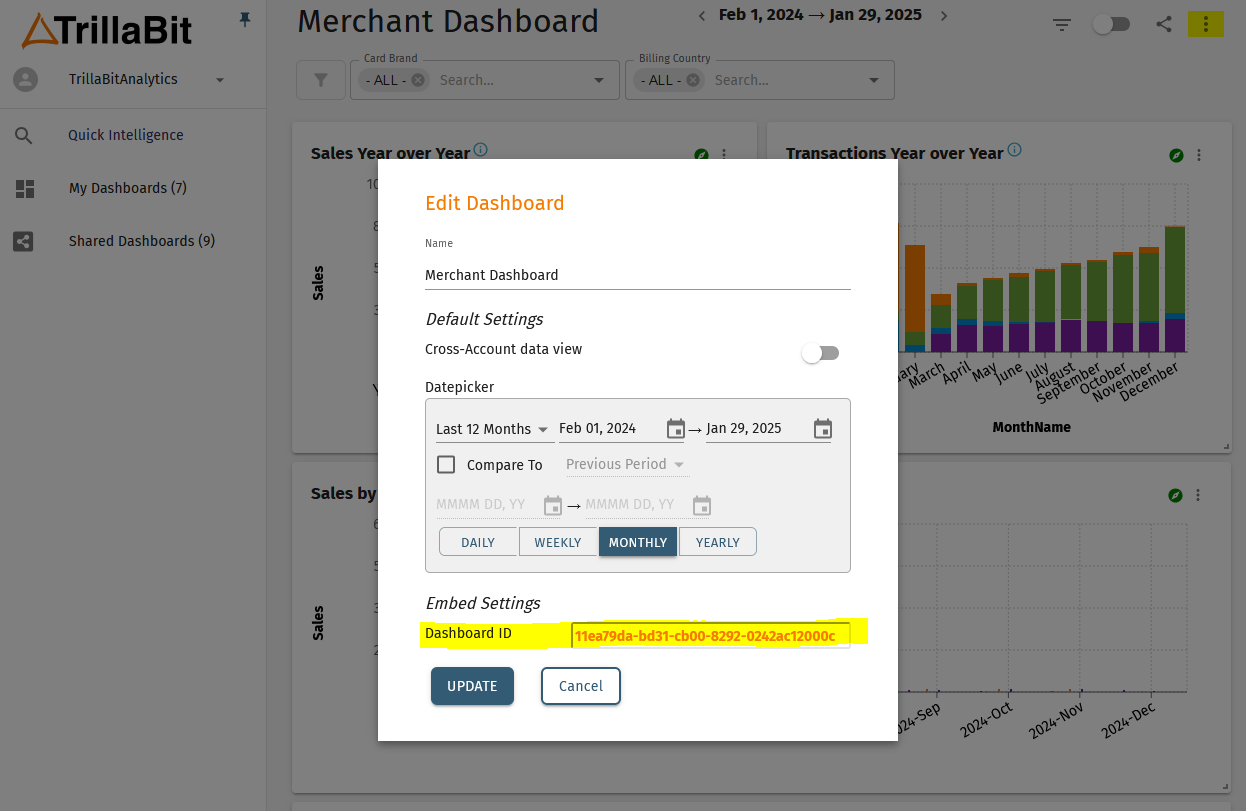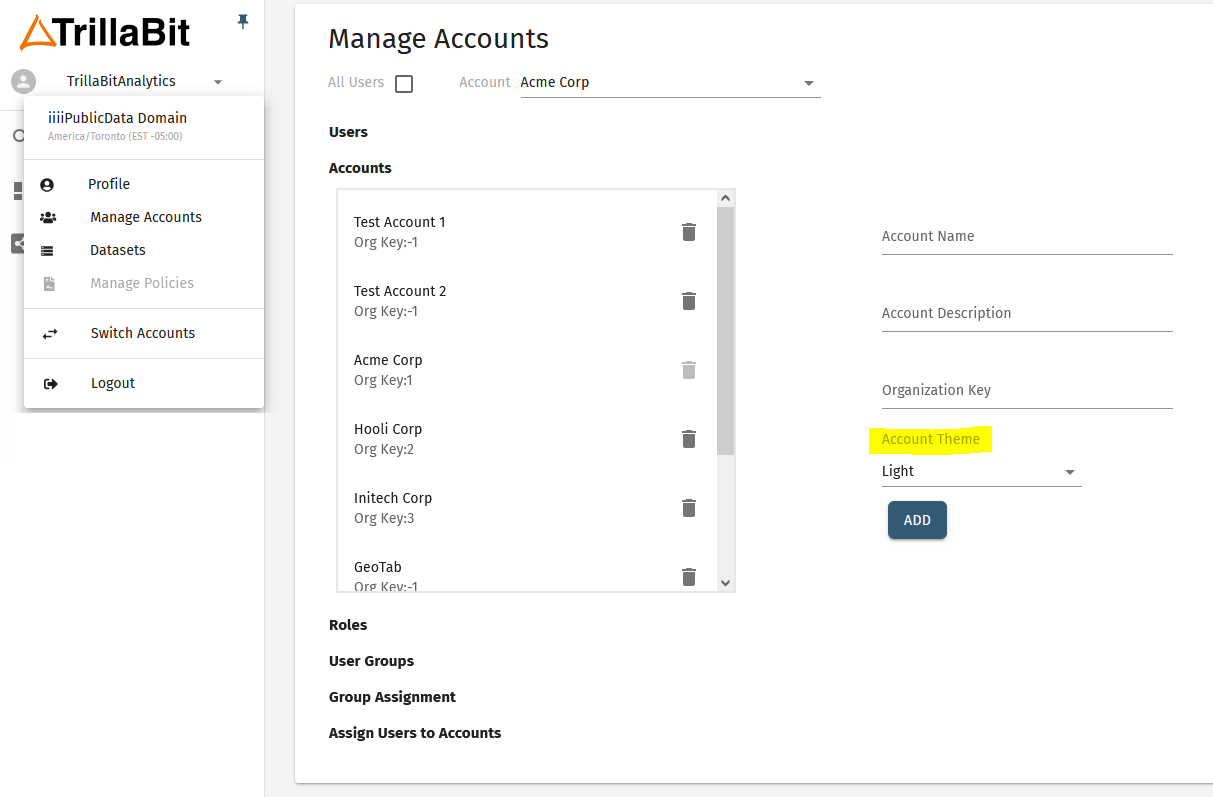TrillaBit Embedding and APIs
Embedding
The method of embedding Quick Intelligence (QI) into your product is currently through an iframe. You can integrate the QI platform into any web-based application by adding an iframe in the desired location and setting the iframe URL.
Quick-Start Guide
To get familiar with the parameters and see it in action, we have created a test harness you can download below to see the QI platform embedded in a sample html page. There are two query string parameters that are available for integration.
- "t" - A JWT token that is used for authentication with the platform
- "d" - A dashboard ID that will navigate the user directly to a specific dashboard
** Before downloading ensure you have a login to the QI platform that you can use as well as a dashboard ID to test with **
You can find the dashboard ID from within the platform when you edit an existing dashboard or call the API for a list of all dashboards associated to the logged in user.

Embedding Flow
- A user with enough permissions to create additional users is provided by TrillaBit.
- Login with the user using the Login User API.
- Once logged in you will have your initial JWT returned.
- Use the JWT with the Create User API to add your users.
- When the user navigates to the page with the embedded iframe:
- Generate the JWT with all the appropriate fields.
- Sign the JWT using your secrey key.
- Set the iframe URL accordingly.
- The user should now be automatically logged into the TrillaBit Quick Intelligence platform.
Embedding the Full Platform
To embed the platform with the side menu you only need to specify the JWT.
The iframe URL should be set as follows:
<iframe src="https://qi.trillabit.com/?t={jwt_token}"/>
Dashboard Mode
To load the application directly into a dashboard, you must add an additional query string parameter. "dashboardID".
<iframe src="https://qi.trillabit.com/?t={jwt_token}&d={dashboardID}"/>
Dashboard ID's are obtained from the List My Dashboards API once you have created at least one dashboard under the user.
Managing your JWT
To ensure that the QI platform is securely authenticating your application you will need to manage the JWT from your host application. This means that you will be generating and signing all JWT's that are set in the iframe. This allow your to control additional details like the expiry date of the JWT and other related parameters. Any settings that need to be sent to the client securely will be through the JWT.
Signing the JWT
You will be provided the signing key for the JWT separately. This will be specific to your organization. You will also be provided the Domain Id and any Account Id's that are associated to your account.
JWT Token Format
This is the format of the JWT token that should be passed so that a user will be authenticated with the system. Details on how to pass it will be provided in a separate document.
Example JWT payload
{
"sub": "[email protected]",
"scopes": ["ACCOUNT_ADMIN", "DOMAIN_ADMIN", "REGULAR"],
"dmn": "aac5bbd0-15b8-11ee-be56-0242ac120002",
"uid": "aa0ede86-15b8-11ee-be56-0242ac120002",
"aid": "aaf652e2-15b8-11ee-be56-0242ac120002",
"mid": "aaa57ff0-15ba-11ee-be56-0242ac120002",
"amid": "aab1673a-15ba-11ee-be56-0242ac120002",
"iss": "TrillaBit",
"iat": 1636893574,
"exp": 1636897174,
"filterAttribute": "[{\"attribute\": \"store_id\",\"value1\": \"1|2|3\",\"operator\": \"contains\"}]",
"readOnlyDashboard": true
}
TrillaBit Specific JWT Attributes
The following are TrillaBit specific attributes:
- "dmn" → Domain Id
- "aid" → Account Id
- "uid" → User Id
- "mid" → Membership Id
- "amid" → Account Member Id
- "readOnlyDashboard" → Determines whether the dashboard that is loaded will be read only if true. Note: This has to be used in combination with the dashboardID query string parameter.
- "filteringAttribute" → Used to apply row-level security through filtering of additional attributes within your dataset's organization key. e.g. the example assumes you are segmenting your sales dataset by department and within each department you want to secure your data at the store level as well. NOTE: This field should be a string and not a json array object.
The other attributes are from the JWT standard. When you create or add a user, these Id’s will be returned to you. Of course, DomainId and AccountId are known in advance since you add the user to that domain and account.
The "iss" attribute needs to be changed accordingly.(Company name is preferred)
Domain refers to Client, and Account refers to Sub-client.
Styling your iframe
You have control on how your iframe is embedded. There are a number of properties and styling you can set. To provide a more seamless experience we would suggest adding a loading animation or hide the iframe until it has finished loading. The theme for the QI application itself can be configured from within the platform at the account-level. We currently have themes for light/dark modes to accomodate most setups. You can find the available themes under the top-left menu -> Manage Accounts -> Accounts tab.

Login APIs
Login User
Method: POST
API Path: api.trillabit.com:8000/login
Headers
'Content-Type': 'application/json'
'X-Requested-With': 'XMLHttpRequest'
Request
{
"userName": "[email protected]",
"password": "complexPassword!"
}
Response
{
"token": "eyadfgadf...",
"refreshToken": "eyzsfgadf..."
}
User APIs
Create User
Method: POST
API Path: api.trillabit.com:8000/api/analytics/external/accountID/users/user
- Domain Id → from JWT token
- Account Id → The accountID that we need to create user under that account
The user will be created under the domain and account that matches with info from the JWT token.
Fields
- userName → should be a valid email address associated with the user
- firstName
- lastName
- accountPhone (Optional)
- userID (Optional) : UUID → in case you want to use the userId from your system; otherwise, don’t pass it.
- roles: [ “Role1” , “Role2” ] → can be existing or new roles
Request
{
"userID": "e20ede86-15b8-11ee-be56-0242ac120002",
"userName": "[email protected]",
"firstName": "John",
"lastName": "Smith",
"accountPhone": "321-321-3211",
"roles": ["Role1", "Role2"]
}
Response
{
"accountID": "fcf652e2-15b8-11ee-be56-0242ac120002",
"accountMemberID": "",
"membershipID": "",
"userID": "e20ede86-15b8-11ee-be56-0242ac120002",
"domainID": "b8c5bbd0-15b8-11ee-be56-0242ac120002"
}
Update User
Method: PUT
API Path: api.trillabit.com:8000/api/analytics/external/accountID/users/user/userID
Request
{
"firstName": "First_name",
"lastName": "Last_name",
"accountPhone": "321-321-3211",
"roles": ["Role3", "Role2"]
}
Response
HTTP 200 OK
Remove User from Account
Method: DELETE
API Path: api.trillabit.com:8000/api/analytics/external/accountID/users/user/userId
Request
(No request body needed)
Response
HTTP 200 OK
List Users
List of users info for the account specified in the URL
Method: GET
API Path: api.trillabit.com:8000/api/analytics/external/accountID/users
Request
(No request body needed)
Response
[
{
"domainID": "b8c5bbd0-15b8-11ee-be56-0242ac120002",
"accountID": "fcf652e2-15b8-11ee-be56-0242ac120002",
"userID": "e20ede86-15b8-11ee-be56-0242ac120002",
"membershipID": "ef511428-15b9-11ee-be56-0242ac120002",
"accountMemberID": "f735ebf0-15b9-11ee-be56-0242ac120002",
"userName": "[email protected]",
"firstName": "John",
"lastName": "Smith",
"accountPhone": "234-1111-376",
"roles": [
{
"roleID": "fd1bdc14-15b9-11ee-be56-0242ac120002",
"roleName": "REGULAR",
"roleDescription": "REGULAR"
}
]
}
]
Account APIs
Create Account
Method: POST
API Path: api.trillabit.com:8000/api/analytics/external/account
Request
{
"accountName": "new_account",
"accountDescription": "new_account_desc",
"organizationKeyValue": "200"
}
Response
HTTP 200 OK
{
"accountID": "fcf652e2-15b8-11ee-be56-0242ac120002"
}
Read Account
Method: GET
API Path: api.trillabit.com:8000/api/analytics/external/account/accountID
Request
(No request body needed)
Response
HTTP 200 OK
{
"accountID": "fcf652e2-15b8-11ee-be56-0242ac120002",
"accountName": "new_account_updated",
"accountDescription": "new_account_updated",
"organizationKeyValue": "-1"
}
Update Account
Method: PUT
API Path: api.trillabit.com:8000/api/analytics/external/account/accountID
Request
{
"accountName": "new_account_updated",
"accountDescription": "new_account_desc_upduated",
"organizationKeyValue": "200"
}
Response
HTTP 200 OK
Delete Account
Method: DELETE
API Path: api.trillabit.com:8000/api/analytics/external/account/accountID
Request
(No request body needed)
Response
HTTP 200 OK
List Accounts
Method: GET
API Path: api.trillabit.com:8000/api/analytics/external/account
Request
(No request body needed)
Response
HTTP 200 OK
[
{
"accountID": "fcf652e2-15b8-11ee-be56-0242ac120002",
"accountName": "new_account_updated",
"accountDescription": "new_account_updated",
"organizationKeyValue": "-1"
}
]
Dashboard APIs
Share Dashboard with User
Method: POST
API Path: api.trillabit.com:8000/api/analytics/external/UserSharedDashboard
Request
{
"userID": "e20ede86-15b8-11ee-be56-0242ac120002",
"dashboardID": "1d230a92-15b9-11ee-be56-0242ac120002"
}
Response
HTTP 200 OK
{
"userSharedDashboardID": "d64eb3f0-15b8-11ee-be56-0242ac120002"
}
Unshare Dashboard
Method: DELETE
API Path: api.trillabit.com:8000/api/analytics/external/UserSharedDashboard
Request
(No request body needed)
Response
HTTP 200 OK
List My Dashboards
Get the list of dashboards shared with you.
Method: GET
API Path: api.trillabit.com:8000/api/analytics/external/UserSharedDashboard/SharedWithMe
Request
(No request body needed)
Response
HTTP 200 OK
[
{
"userSharedDashboardID": "d64eb3f0-15b8-11ee-be56-0242ac120002",
"accountID": "fcf652e2-15b8-11ee-be56-0242ac120002",
"dashboardID": "1d230a92-15b9-11ee-be56-0242ac120002",
"user": null,
"dashboard": {
"dashboardName": "My Dashboard",
"dashboardDescription": "My Dashboard"
}
}
]